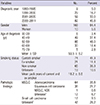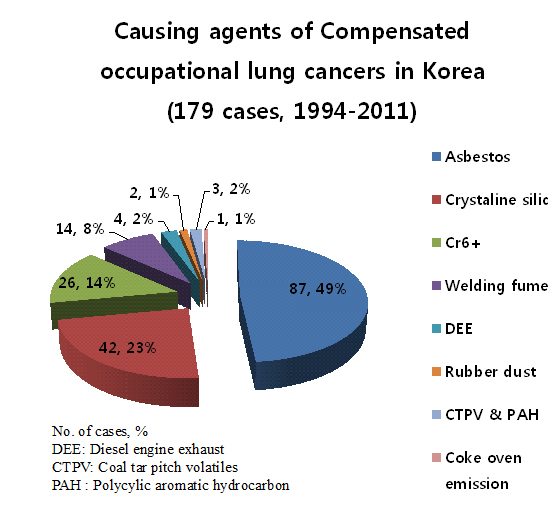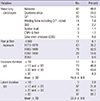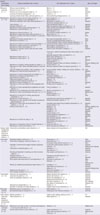1. Jung KW, Won YJ, Kong HJ, Oh CM, Seo HG, Lee JS. Cancer statistics in Korea: incidence, mortality, survival and prevalence in 2010. Cancer Res Treat. 2013; 45:1–14.
2. Doll R, Peto R. The causes of cancer: quantitative estimates of avoidable risks of cancer in the United States today. J Natl Cancer Inst. 1981; 66:1191–1308.
3. Nurminen M, Karjalainen A. Epidemiologic estimate of the proportion of fatalities related to occupational factors in Finland. Scand J Work Environ Health. 2001; 27:161–213.
4. Boffetta P. Epidemiology of environmental and occupational cancer. Oncogene. 2004; 23:6392–6403.
5. Kim SY, Ohrr H, Kang HG, Kim SI, Yi SW. Cancer incidence in Kangwha county(1986 - 1992). Korean J Prev Med. 1999; 32:482–490.
6. Kim EA, Lee HE, Kang SK. Occupational burden of cancer in Korea. Saf Health Work. 2010; 1:61–68.
7. Son MA, Lee WJ, Jin YW. The burden of occupational cancer in Korea. Seoul: Ministry of Health and Welfare;2010.
8. Kang SK, Ahn YS, Chung HK. Occupational cancer in Korea in the 1990s. Korean J Occup Environ Med. 2001; 13:351–359.
9. Travis WD, Brambilla E, Noguchi M, Nicholson AG, Geisinger KR, Yatabe Y, Beer DG, Powell CA, Riely GJ, Van Schil PE, et al. International association for the study of lung cancer/american thoracic society/european respiratory society international multidisciplinary classification of lung adenocarcinoma. J Thorac Oncol. 2011; 6:244–285.
10. Travis WD, Brambilla E, Noguchi M, Nicholson AG, Geisinger K, Yatabe Y, Ishikawa Y, Wistuba I, Flieder DB, Franklin W, et al. Diagnosis of lung cancer in small biopsies and cytology: implications of the 2011 International Association for the Study of Lung Cancer/American Thoracic Society/European Respiratory Society classification. Arch Pathol Lab Med. 2013; 137:668–684.
11. Ministry of Labor. Analyses of industrial accidents in 2010. Gwacheon: Ministry of Employment and Labor;2011.
13. Raffn E, Lynge E, Korsgaard B. Incidence of lung cancer by histological type among asbestos cement workers in Denmark. Br J Ind Med. 1993; 50:85–89.
14. Karjalainen A, Anttila S, Vanhala E, Vainio H. Asbestos exposure and the risk of lung cancer in a general urban population. Scand J Work Environ Health. 1994; 20:243–250.
15. Johansson L, Albin M, Jakobsson K, Mikoczy Z. Histological type of lung carcinoma in asbestos cement workers and matched controls. Br J Ind Med. 1992; 49:626–630.
16. Offermans NS, Vermeulen R, Burdorf A, Goldbohm RA, Kauppinen T, Kromhout H, van den Brandt PA. Occupational asbestos exposure and risk of pleural mesothelioma, lung cancer, and laryngeal cancer in the prospective Netherlands cohort study. J Occup Environ Med. 2014; 56:6–19.
17. Baker JE, Reutens DC, Graham DF, Sterrett GF, Musk AW, Hobbs MS, Armstrong BK, de Klerk NH. Morphology of bronchogenic carcinoma in workers formerly exposed to crocidolite at Wittenoom Gorge in Western Australia. Int J Cancer. 1986; 37:547–550.
18. de Klerk NH, Musk AW, Eccles JL, Hansen J, Hobbs MS. Exposure to crocidolite and the incidence of different histological types of lung cancer. Occup Environ Med. 1996; 53:157–159.
19. Park SK, Cho LY, Yang JJ, Park B, Chang SH, Lee KS, Kim H, Yoo KY, Lee CT. Scientific Committee Korean Academy of Tuberculosis and Respiratory Diseases. Lung cancer risk and cigarette smoking, lung tuberculosis according to histologic type and gender in a population based case-control study. Lung Cancer. 2010; 68:20–26.
20. Khuder SA. Effect of cigarette smoking on major histological types of lung cancer: a meta-analysis. Lung Cancer. 2001; 31:139–148.
21. Wagner GR, Hearl FJ. Mineral dusts: asbestos, silica, coal, manufactured fibers. In : Rosenstock L, Cullen MR, Brodkin CA, Redlich CA, editors. Textbook of clinical occupational and environmental medicine. 2nd ed. New Haven: Elsevier Saunders;2005. p. 1073–1078.
22. Kishimoto T, Ohnishi K, Saito Y. Clinical study of asbestos-related lung cancer. Ind Health. 2003; 41:94–100.
23. Ulm K, Waschulzik B, Ehnes H, Guldner K, Thomasson B, Schwebig A, Nuss H. Silica dust and lung cancer in the German stone, quarrying, and ceramics industries: results of a case-control study. Thorax. 1999; 54:347–351.
24. Luippold RS, Mundt KA, Austin RP, Liebig E, Panko J, Crump C, Crump K, Proctor D. Lung cancer mortality among chromate production workers. Occup Environ Med. 2003; 60:451–457.
25. Korallus U, Ulm K, Steinmann-Steiner-Haldenstaett W. Bronchial carcinoma mortality in the German chromate-producing industry: the effects of process modification. Int Arch Occup Environ Health. 1993; 65:171–178.
26. Rosenman KD, Stanbury M. Risk of lung cancer among former chromium smelter workers. Am J Ind Med. 1996; 29:491–500.
27. Langård S. One hundred years of chromium and cancer: a review of epidemiological evidence and selected case reports. Am J Ind Med. 1990; 17:189–215.
28. Reid A, de Klerk NH, Ambrosini GL, Berry G, Musk AW. The risk of lung cancer with increasing time since ceasing exposure to asbestos and quitting smoking. Occup Environ Med. 2006; 63:509–512.
29. Huuskonen MS. Clinical features, mortality and survival of patients with asbestosis. Scand J Work Environ Health. 1978; 4:265–274.
30. Sluis-Cremer GK. Asbestos disease at low exposures after long residence times. Ann N Y Acad Sci. 1991; 643:182–193.
31. Karjalainen A, Pukkala E, Kauppinen T, Partanen T. Incidence of cancer among Finnish patients with asbestos-related pulmonary or pleural fibrosis. Cancer Causes Control. 1999; 10:51–57.
32. Oksa P, Klockars M, Karjalainen A, Huuskonen MS, Vattulainen K, Pukkala E, Nordman H. Progression of asbestosis predicts lung cancer. Chest. 1998; 113:1517–1521.
33. Finkelstein MM. Radiographic asbestosis is not a prerequisite for asbestos-associated lung cancer in Ontario asbestos-cement workers. Am J Ind Med. 1997; 32:341–348.
34. Edge JR. Asbestos related disease in Barrow-in-Furness. Environ Res. 1976; 11:244–247.
35. Fletcher DE. A mortality study of shipyard workers with pleural plaques. Br J Ind Med. 1972; 29:142–145.
36. Hillerdal G, Henderson DW. Asbestos, asbestosis, pleural plaques and lung cancer. Scand J Work Environ Health. 1997; 23:93–103.
37. International Agency for Research on Cancer. IARC monographs on the evaluation of carcinogenic risks to humans: Volume 100C: a review of human carcinogens: arsenic, metals, fibres, and dusts. Lyon: International Agency for Research on Cancer;2012. p. 219–309.
38. Kang SK. Asbestos exposure and its health effects in Korea. Lyon: International Agency for Research on Cancer;2008. p. 7.
39. In : Hisanaga N, Shibata E, Sakai K, Kamijima M, Kubota H, Mori I, editors. Lessons from asbestos-related cancers in Japan. 18th World Congress on Safety and Health at Work; 2008 June 29 - July 2; Seoul, Republic of Korea. Genève: International Labour Organization (ILO),the International Social Security Association (ISSA);2008.
40. Ahn YS, Won JU, Park RM. Cancer morbidity of foundry workers in Korea. J Korean Med Sci. 2010; 25:1733–1741.





 PDF
PDF ePub
ePub Citation
Citation Print
Print








 XML Download
XML Download